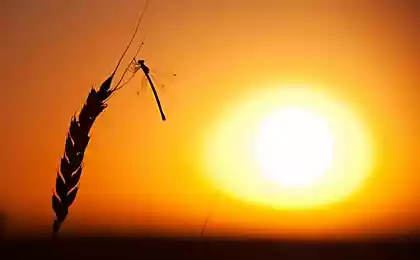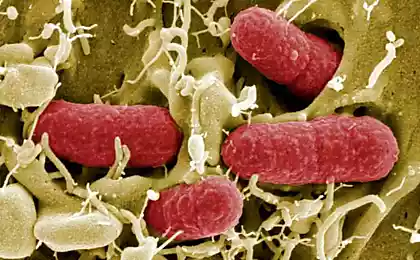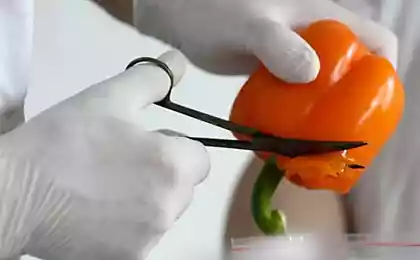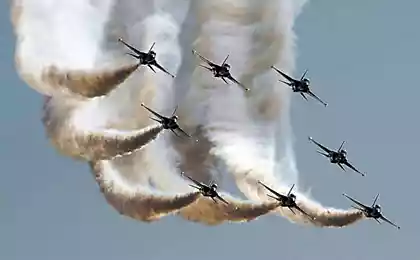757
The strangest creatures 2011
Each year, biologists and zoologists from all over the world make up a kind of hits the most interesting inhabitants of our planet. In 2010, scientists found "on unknown paths" of "unprecedented animals": Pinocchio frog-flower-eating rats, worms, firing "bombs", and even a mushroom named modest phallus.
This year the ten most interesting species called the International Institute survey forms (International Institute for Species Exploration) Arizona State University (USA)
Worm-bite teeth daggers
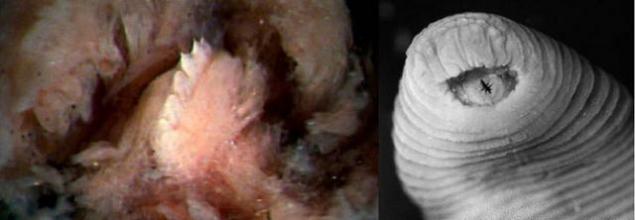
Unlike conventional leeches have three jaws with tiny microscopic pits fifty-long teeth 0, 012 mm, scientists found a kind of terrified. Just imagine, this puny 5 cm long grow a single, but very large jaw, which adorn the eight teeth-like daggers (leech, of course), the length of 0, 13 mm. They she is stuck in his favorite "treat" - the noses of animals and people - and drinking the blood through the mucous membrane.
She first caught the eye of experts in Peru, when it turned nose eight girls swim in the Amazon. Unlike other leeches that leave the victim, drunk the blood, it may suck for a few days or even weeks. Mouth and bloodthirsty leeches inspired researchers to the Tyrannobdella rex - in honor of the Tyrannosaurus rex Tyrannosaurus.
Darwin's bark spider weaves a network of stronger than steel

Spider Caerostris darwini named after the famous naturalist Charles Darwin because it started its study of 24 November 2009 (and finished only this year) - on the day that was exactly 150 years since the publication of the first edition of the book "The Origin of Species." < br />
This insect is so laboriously, as if he wanted to prove slightly pereinachenny Darwinian postulate: if the work of a monkey can make a person, then the spider-workaholic - the leader of the hit parade.
The fact that none of his colleagues in the world weaves such a giant network, whose total area can reach about three square meters, and "shoots" webs 25 meters long.
And his thread so strong that chemists envy: they are ten times stronger than Kevlar - the strongest synthetic fiber that is five times stronger than steel. From it are made bulletproof vests. Its network spiders often stretch across the mountain rivers and streams. Every day they get a few dozen insects. He lives in Madagascar.
Cockroach jumps better than a grasshopper
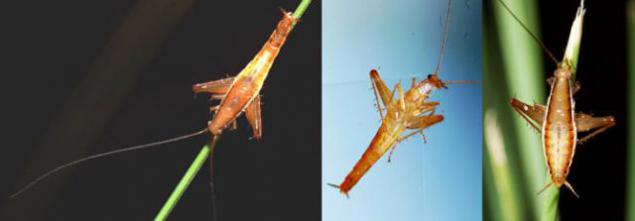
In South Africa, in the rainforest on the slopes of Table Mountain near Cape Town - the main tourist attractions of the republic - Biologists have found a new species of cockroaches Saltoblattella montistabularis. He jumps better than a grasshopper, his eyes in the form of hemispheres, the outstanding sides of the head, and antennae with an additional point of fixation to stabilize during the jump.
Until recently, about jumping cockroaches scientists knew only fossil late Jurassic period (196-175 million. Years ago). Where did this living fossil? Perhaps it's an alien? - Joke researchers.
The bacterium

This new type of bacteria living on iron oxide was found in the sunken "Titanic." Studies show that it adheres to the steel surface, creating corrosion products, which have contributed, along with other microorganisms, to a deterioration of the metal "Titanic».
This will eventually lead to the disappearance of the "Titanic". This bacterium may be useful to conduct research related to the study of old naval and merchant ships that sank in the ocean depths.
Varan Forest or Golden Spotted

It is a big tree frugivorous lizard genus Varanus and can only be found in the woods of Northern Sierra Madre, Luzon, Philippines. The lizard can grow to more than 2 meters in length but weighs only about 10 kg (22lb).
It is striking to think that something this size eluded biologists because it spends most of its time in trees. However, he was known to local hunters.
Underwater mushroom
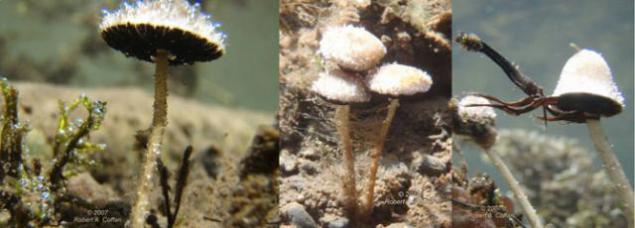
The first report about the existence of underwater species of fungi fruiting. Habitat: the United States, in southern Oregon, Jackson County
Fish Shoot has grown legs
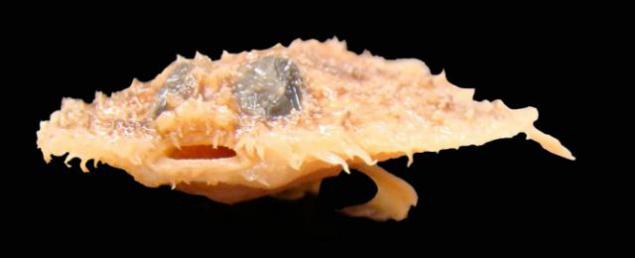
Deep sea fish Halieutichthys intermedius like a cartoon character - a sort of pancake Crunchy pupyrchatoy with huge bulging eyes and legs, fins, in which he walks, and even jumping on the bottom. And when the "pancake" opens his mouth, it is as if he wanted to say the words of our Bun: "I left my grandmother, my grandfather, I left ...»
Some researchers call it even Batfish - «fish - a bat." In rodent volatile it becomes like when swimming. This unusual species was discovered just before the oil spill in the Gulf of Mexico in 2010. And today, it has to be saved from the consequences of ecological catastrophe.
Walter's Duiker
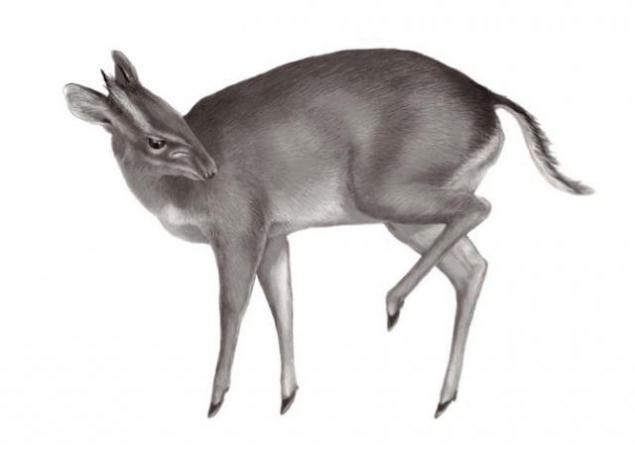
This new duiker from West Africa first met in Benin (328 m above sea level), near the Environmental Center Manigri. This is surprising, therefore opening new kinds of well-studied groups of animals in the wild is a sobering reminder of the kinds of mammals that have not been described, even in those that are operated on a daily basis for food. Taxonomic description Philantomba walteri should promote the study of its ecology and behavior, as well as its preservation.
Mushrooms shine to the music of Mozart ...

Botanists are recognized when they are in Brazil, Sao Paulo, seen in the darkness of the forest huge meadow, where blazing yellow-green stalks strange, I thought that they had hallucinations. Later, when they realized that they face bioluminescent mushrooms, they decided to call Mycena luxaeterna - mushrooms "eternal light» (lux - light aeterna - eternal) in honor of the eponymous part of the "Requiem" by Mozart. Of the approximately 1, 5 million species of fungi in the world only 71 species have the ability to emit light, and Mycena luxaeterna - one of the most striking species.
Cricket pollinated orchid

All credit Cricket Glomeremus orchidophilus - pollinate unique orchid Angraecum cadetii, growing on the island of Reunion in the Indian Ocean. But in addition to it, the job no one in the world can not do. This insect disappears - there will be a beautiful flower. In addition, the cause of their falling into hits in the fact that he - the only representative of the family of Orthoptera (This includes, in particular, all known locusts), able to pollinate the flowers.
This year the ten most interesting species called the International Institute survey forms (International Institute for Species Exploration) Arizona State University (USA)
Worm-bite teeth daggers

Unlike conventional leeches have three jaws with tiny microscopic pits fifty-long teeth 0, 012 mm, scientists found a kind of terrified. Just imagine, this puny 5 cm long grow a single, but very large jaw, which adorn the eight teeth-like daggers (leech, of course), the length of 0, 13 mm. They she is stuck in his favorite "treat" - the noses of animals and people - and drinking the blood through the mucous membrane.
She first caught the eye of experts in Peru, when it turned nose eight girls swim in the Amazon. Unlike other leeches that leave the victim, drunk the blood, it may suck for a few days or even weeks. Mouth and bloodthirsty leeches inspired researchers to the Tyrannobdella rex - in honor of the Tyrannosaurus rex Tyrannosaurus.
Darwin's bark spider weaves a network of stronger than steel

Spider Caerostris darwini named after the famous naturalist Charles Darwin because it started its study of 24 November 2009 (and finished only this year) - on the day that was exactly 150 years since the publication of the first edition of the book "The Origin of Species." < br />
This insect is so laboriously, as if he wanted to prove slightly pereinachenny Darwinian postulate: if the work of a monkey can make a person, then the spider-workaholic - the leader of the hit parade.
The fact that none of his colleagues in the world weaves such a giant network, whose total area can reach about three square meters, and "shoots" webs 25 meters long.
And his thread so strong that chemists envy: they are ten times stronger than Kevlar - the strongest synthetic fiber that is five times stronger than steel. From it are made bulletproof vests. Its network spiders often stretch across the mountain rivers and streams. Every day they get a few dozen insects. He lives in Madagascar.
Cockroach jumps better than a grasshopper

In South Africa, in the rainforest on the slopes of Table Mountain near Cape Town - the main tourist attractions of the republic - Biologists have found a new species of cockroaches Saltoblattella montistabularis. He jumps better than a grasshopper, his eyes in the form of hemispheres, the outstanding sides of the head, and antennae with an additional point of fixation to stabilize during the jump.
Until recently, about jumping cockroaches scientists knew only fossil late Jurassic period (196-175 million. Years ago). Where did this living fossil? Perhaps it's an alien? - Joke researchers.
The bacterium

This new type of bacteria living on iron oxide was found in the sunken "Titanic." Studies show that it adheres to the steel surface, creating corrosion products, which have contributed, along with other microorganisms, to a deterioration of the metal "Titanic».
This will eventually lead to the disappearance of the "Titanic". This bacterium may be useful to conduct research related to the study of old naval and merchant ships that sank in the ocean depths.
Varan Forest or Golden Spotted

It is a big tree frugivorous lizard genus Varanus and can only be found in the woods of Northern Sierra Madre, Luzon, Philippines. The lizard can grow to more than 2 meters in length but weighs only about 10 kg (22lb).
It is striking to think that something this size eluded biologists because it spends most of its time in trees. However, he was known to local hunters.
Underwater mushroom

The first report about the existence of underwater species of fungi fruiting. Habitat: the United States, in southern Oregon, Jackson County
Fish Shoot has grown legs

Deep sea fish Halieutichthys intermedius like a cartoon character - a sort of pancake Crunchy pupyrchatoy with huge bulging eyes and legs, fins, in which he walks, and even jumping on the bottom. And when the "pancake" opens his mouth, it is as if he wanted to say the words of our Bun: "I left my grandmother, my grandfather, I left ...»
Some researchers call it even Batfish - «fish - a bat." In rodent volatile it becomes like when swimming. This unusual species was discovered just before the oil spill in the Gulf of Mexico in 2010. And today, it has to be saved from the consequences of ecological catastrophe.
Walter's Duiker

This new duiker from West Africa first met in Benin (328 m above sea level), near the Environmental Center Manigri. This is surprising, therefore opening new kinds of well-studied groups of animals in the wild is a sobering reminder of the kinds of mammals that have not been described, even in those that are operated on a daily basis for food. Taxonomic description Philantomba walteri should promote the study of its ecology and behavior, as well as its preservation.
Mushrooms shine to the music of Mozart ...

Botanists are recognized when they are in Brazil, Sao Paulo, seen in the darkness of the forest huge meadow, where blazing yellow-green stalks strange, I thought that they had hallucinations. Later, when they realized that they face bioluminescent mushrooms, they decided to call Mycena luxaeterna - mushrooms "eternal light» (lux - light aeterna - eternal) in honor of the eponymous part of the "Requiem" by Mozart. Of the approximately 1, 5 million species of fungi in the world only 71 species have the ability to emit light, and Mycena luxaeterna - one of the most striking species.
Cricket pollinated orchid

All credit Cricket Glomeremus orchidophilus - pollinate unique orchid Angraecum cadetii, growing on the island of Reunion in the Indian Ocean. But in addition to it, the job no one in the world can not do. This insect disappears - there will be a beautiful flower. In addition, the cause of their falling into hits in the fact that he - the only representative of the family of Orthoptera (This includes, in particular, all known locusts), able to pollinate the flowers.






